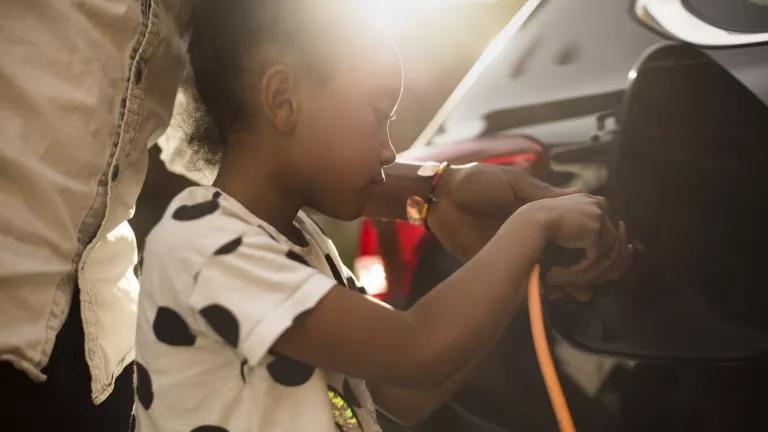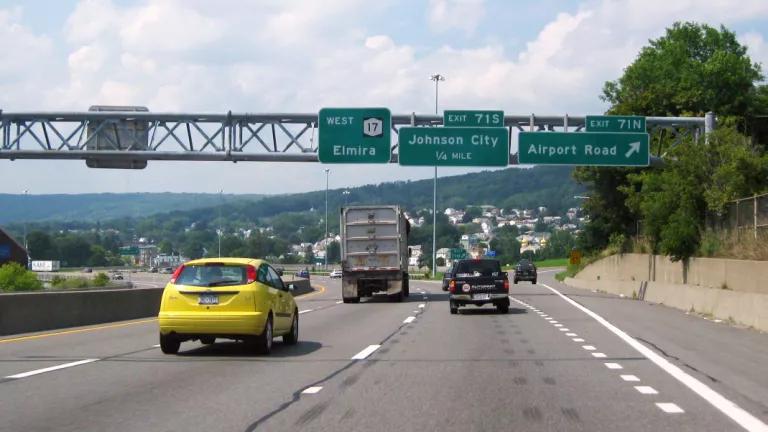Clean Trucks New York Program to Bring Significant Benefits
A new report outlines the health, climate, and economic benefits of New York State adopting the Advanced Clean Trucks rule.

New York Governor Hochul gave the green light last week for the state to move forward with the Advanced Clean Trucks (ACT) rule. The directive on the ACT to the New York Department of Environmental Conservation (DEC) represents one of the first actions of her Administration to mitigate climate and air pollution. The ACT rule requires vehicle manufacturers to sell an increasing percentage of zero-emission trucks and buses through 2035. This follows strong support from representatives of public health, business, environmental justice, and environmental organizations in support of Governor Hochul taking action to protect the state from deadly diesel truck pollution. As a next step, New York could also adopt the Heavy-Duty Omnibus (HDO) rule, which would make emissions standards more stringent for new fossil fuel trucks, as part of a Clean Trucks New York Program.
To evaluate the impacts of these rules, NRDC and the Union of Concerned Scientists commissioned M.J. Bradley & Associates to conduct a report with both Clean Water Action and New Jersey Environmental Justice Alliance serving as advising contributors to the project. The findings show the program would deliver over 440,000 zero-emission trucks to the Empire State together with $21.4 billion in public health, environmental, and economic benefits through 2050.
The Clean Trucks regulations will bring public health, climate, and economic benefits to New Yorkers
With New York and the Northeast still recovering from the devastating effects and human toll of Hurricane Ida, there is no time to lose in preventing the climate crisis from getting worse. New York took an important step towards addressing climate change when it passed the Climate Leadership and Community Protection Act (CLCPA), which requires a 40% reduction in greenhouse gases by 2030 and 85% reductions by 2050. The state’s next steps will need to adopt bold programs like the Clean Trucks NY program to meet those requirements.
Today, transportation emits more greenhouse gases than any other sector, and within that, trucks and buses are especially big emitters. To achieve the goals of the CLCPA, New York must zero-out pollution from the transportation sector—including the state’s commercial trucks and buses.
Air pollution from trucks and buses is also an urgent threat to public health, especially in low-income areas and communities of color, which have faced a disproportionate pollution burden for decades. Trucks and buses spew nitrogen oxides, a contributor to smog, and particulate matter that can cause damage to the heart and lungs. Clean Trucks NY would help the residents avoid over 350,000 air pollution-related cases through 2050 including acute bronchitis, asthma exacerbations and other respiratory symptoms together with hundreds of premature deaths. And in that timeframe, the rules would avoid over $6.3 billion in public health impacts. If New York adopts additional policies designed specifically with impacted communities in mind—such as policies focused on deployment in pollution impacted communities, the state could reduce the pollution burden felt by disadvantaged communities.
Clean Trucks NY will also bring the state economic benefits. Due to falling costs of technology, lower fueling costs and maintenance costs, by 2030 fleets would see ZEVs being cost effective. By 2050, state fleet owners would see $318 million annual in savings in terms of total costs of ownership. The rules will also drive investments in infrastructure from utilities, businesses, and the public sector, priming New York to eventually support a fully zero-emission truck and bus fleet. The ACT and HDO rules are expected to spur nearly $2.5 billion in public and private investments in charging infrastructure, which will support well-paying construction jobs in the state. And the jobs added are expected to have salaries that are roughly double those of jobs that are replaced.
New Yorkers want these rules
Recent polling data shows that there is broad, bipartisan support, with over 76% of New York residents stating that they want to see the state adopt the ACT. Twenty-four New York environmental justice, health, environmental, and business groups have already written a letter urging the state to move forward with the ACT and HDO rules.
There’s no time to waste in adopting the Clean Trucks NY Program
The DEC can now take the move the ACT rule forward, but New York shouldn’t stop there. The state should adopt the HDO rule as well to limit pollution from new fossil fuel trucks. And when finalized, New York should move forward with the Advanced Clean Fleets rule, a purchasing requirement for fleets. The ACT is just the first step in a series of policies that will clean up diesel pollution in New York State.




